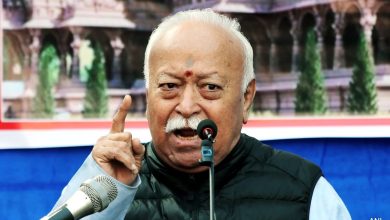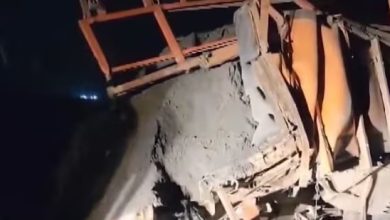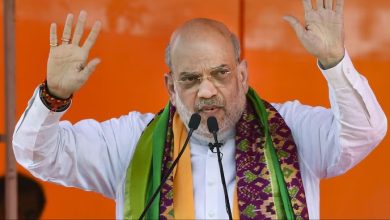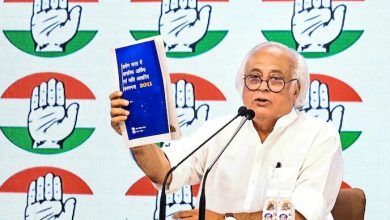New Delhi. As the pollution levels in the nation’s capital soared to unprecedented levels on Sunday, the Delhi government unveiled a slew of measures, including the closure of all schools for three days, to battle the unprecedented smog levels that drastically reduced visibility and turned the city into a virtual “gas chamber”. Chief minister Arvind Kejriwal also banned construction and demolition work for five days as well as the use of diesel-run generator sets for 10 days in a desperate bid to control a crisis that has left Delhi choked.
The chief minister said his government was also mulling the possibility of bringing back the “odd-even” car rationing scheme and was going to discuss with the Centre the possibility of engineering artificial rain over the city to counter the effects of large-scale crop burning in Haryana and Punjab.
The school closure is aimed at preventing children from being affected by the dangerous pollution levels that have forced people to use surgical masks while travelling in the city. But Mr Kejriwal insisted this was a larger problem that also involved the neighbouring states, where farmers are said to be burning crop stubble over a wide area, and has sought the Central government’s intervention.
“This is a time to set aside politics and find a solution (to the problem),” Mr Kejriwal said after presiding over an emergency Cabinet meeting. “The base level of pollution is already very high. We have consulted experts and are taking some emergency measures,” the CM said.
The Delhi government also decided to shut down the coal-based Badarpur power plant, considered a key source of pollution, for the next 10 days starting Monday. The plant generates around 300 MW power. It was also decided to go in for water sprinkling on roads of 100-foot width from Monday. This will be done by the PWD on all such roads at least once a week.
A committee comprising the chief secretary and the environment secretary will take up with the Centre the possibility of engineering artificial rain over Delhi so that the dust settles down, the CM said, adding the Cabinet had also got a proposal to go in for artificial rain through cloud seeding.
Mr Kejriwal said the government would strictly enforce the ban on burning of leaves and other waste and officers would be held accountable for any lapses in their areas of jurisdiction. The environment department has been told to launch an app immediately to enable the public to report cases of burning of leaves and garbage. It was also decided at the Cabinet meeting to start vacuum cleaning of roads from November 10.
Mr Kejriwal said all construction and demolition work in the city had been banned for five days, and the municipal corporations have been told ensure that fires from landfill sites are immediately put out.
On Saturday, Mr Kejriwal had met Union minister of state for environment Anil Dave and discussed a series of steps to deal with the alarming air pollution. Mr Dave has called an emergency meeting of the environment ministers of Delhi and its neighbouring states on Monday.
A Delhi government statement later on Sunday said the departments concerned had been directed to start making preparations for the odd-even scheme. It said the transport of fly ash from the Badarpur plant was banned for 10 days and water would be sprinkled on the fly ash dump there.
The government said advisories will be issued by the health and environment departments on the prevailing situation. The chief minister said power connections will be provided even in unauthorised colonies to tackle the menace of diesel generator sets. This did not mean power connections would be regularised though, he said.
Mr Kejriwal stressed the need to hammer out solutions with the cooperation of all. He also said the extent of crop burning was way above that seen in the past few years. “The government is not unprepared. No one thought crop burning will be of this scale and weather conditions are also inclement. Delhi was polluted, so the extra pollutants aggravated the situation,” he said.
The dense cover of grey haze shrouding Delhi for almost a week, reminiscent of the 1952 Great Smog in London, plunged the city’s air quality to the season’s worst, with even the 24-hour average threatening to go past the maximum limit. The real-time readings of respirable pollutants PM 2.5 and PM 10 breached the safe standards by over 17 times at many places. The hourly AQI (air quality index) of monitoring stations run by CPCB and SAFAR remained 500 plus, that is beyond the maximum limit.
Experts said while the level of sulphur dioxide (SO2) is still in control in the city, in terms of other parameters like volume of particulates, the situation was nearly as bad as the infamous London episode that had led to around 4,000 premature deaths.
“In the London smog of 1952, about 4,000 people died prematurely when average PM levels were about 500 microgramme per cubic metre along with high SO2 levels. Here (the concentration of) SO2 may not be that high, but as we saw on Diwali, several gases had increased substantially. Overall it is a toxic cocktail.
“Persisting high levels can lead to more premature deaths in Delhi also,” Anumitra Roychowdhury of the Centre for Science and Environment (CSE) said.
Air pollution is responsible for around 10,000 to 30,000 deaths in the national capital every year, the CSE had said in a report last year.
At 4 pm, the 24-hour-average AQI of the city was at a staggering 497, three steps down the maximum of 500, which was the season’s worst, even compared to post-Diwali pollution levels.
Real-time readings of the Delhi Pollution Control Committee (DPCC) showed that Anand Vihar had PM 10 (coarse particles with diameter of 10 micrometres) reading of 1,690 micrograms per cubic metre in the morning, that came down a few notches during the day before spiking in the afternoon again.
At R.K. Puram, PM 2.5 touched 885 at 12.30 pm as against the safe limit of 60 micrograms per cubic metre. The 24-hour prescribed standard of PM 10 is 100.
The CSE, which said the prevailing spell of smog in Delhi was the worst in 17 years, welcomed the emergency steps like shutting down of schools and power plants announced by the city government.
“The emergency situation has persisted for about a week now. But we should keep in mind such measures are only aimed at bringing peak levels down,” Ms Roychowdhury said.






